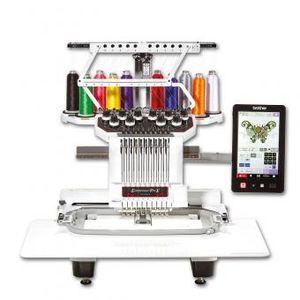Brother PR1050X
Introduction
The Brother PR1050X is a high-end consumer and professional entry level embroidery machine.
In Switzerland, list price is 12'000 CHF, in Germany 11'000 Euros. Street prices can be less and even lesser for education.
I ordered such a model and by fall 2017 there should be more information in this page - Daniel K. Schneider (talk) 09:02, 4 July 2017 (CEST)
Specifications
- The machine can stitch up to 10 different colors with one needle at the time
- Size: 48 x 48 x 60cm ?
- Size of the box: ?
- Weight: 44 kg (60 kg in the box ?)
- Size of a table (add-on): 70 - 100 cm height, 49 cm length, 80 cm width
Connectivity
- USB host cable
- USB media slot
- SD card slot
Thread colors
- Default colors
- Each needle bar can be assigned a color through either the control panel or software (the latter is called manual color sequence).
- Thread colors in a design can be sorted at the control panel (this may mess up order of printing of course)
- Several manufacturers/makes color schemes are builtin. E.g. Madeira Poly, Sulky, R-A Poly.
Formats
The Machine can not directly stitch from design files like EMB or ART.
PES
- The PES format is the most important native machine instruction format for both small and semi-professional Brother embroidery machines. Designs can be somewhat modified.
- Several version of PES seem to exist. Newer versions may not work on older machines
- PES is the default format to export from your embroidery software.
PEN
- A Brother format that only works on some machines that can stitch "Disney" designs. Some machines can be registered to decrypt.
PEC
- An older Baby Lock/Brother/Deco format. Avoid.
PHC
- Older Brother format. Avoid.
DST
- DST is a Tajima data file and it does not include color information (therefore avoid)
Hoops
Standard
Compact Frame
Use of stabilizers
There are several types of stabilizers, e.g.
- Water soluble: Used for freestanding lace (FSL) and also as topping for some fabrics, e.g. towels
- Self-adhesive tear away: Used for heavy fabrics (but also lighter and softer ones with less good results since , but it is the most easy to use)
- Tear away: Medium-heavy woven fabrics and sturdy fabrics. This has to be ironed or glued to the fabric depending on the brand.
- Polyester mesh cut away: Used for T-shirts and similar
- Cut-away: pullovers and such
The Brother Operation manual (p. 254) recommends fabric/stabilizer combinations of which we reproduce some modified excerpts:
| Fabric/Garment | No. of Backing Pieces | No. of Topping Pieces | Comments |
|---|---|---|---|
| Denim | 1 tear-away | None | Lower speed if problems |
| Terry cloth (bath towels) | 1 tear-away | 1 water soluble | Increase density and avoid small lettering. |
| Fine woven shirts | 1 tear-away | None | For high-density or highly detailed designs use two pieces of lightweight backing |
| Golf shirt | 1 cut-away | Optional | |
| Corduroy | 1 tear-away | 1 water-soluble | Use denser stitcher or denser/more understiches. |
| Lingerie or silk | 1 or 2 lightweight tear-away | Optional | Reduce sewing speed |
| Knitting (sweater) | 1 cut-away or adhesive tear-away | 1 water-soluble | Use tightly woven organza or curtain fabric in a matching color if knits have holes. |
| Sweatshirt | 1 cut-away or adhesive tear-away | Optional | Two layers for detailed designs |
| T-shirt | 1 light-weight cut-away or adhesive tear-away | Optional | Avoid stitch-heavy designs and make them low tension. |
As general rule:
- Any fabric needs a stabilizer. If you are lazy use at least the auto-adhesive one.
- Very small lettering needs topping on most fabrics.
- Fine fabrics should use cut-away stabilizers. These are nicer to wear and some offer extra stability.
The Touch Screen Interface
Embroidery Settings
(chapter 4 of the manual) Color settings (p 133, 143)
- On page 5 of the settings screen, set manual color sequence to
on
Machine Settings
The settings screen includes seven screens
Links
Official
- Manuals and Drivers
- Manuals in French
